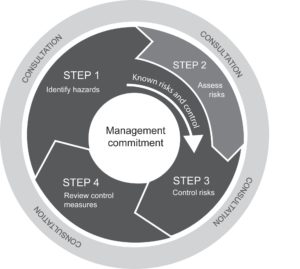WHS Risk Control
What do companies do to control risks?
The focus of company WHS programs is on the prevention of work related illness and injury. In order to prevent injury the company has programs focusing on identifying hazards before they result in accidents and rectifying any factors that may contribute to accidents. This is called risk management. WHS programs focusing on identifying risks and rectifying factors that may contribute to accidents include:
- Conducting workplace inspections and audits and eliminating hazards wherever possible
- Conducting risk assessments of jobs, plant and equipment and other high risk areas such as possible emergencies and eliminating hazards wherever possible
- Encouraging the workforce to report hazards or incidents
- Illness and injury statistics including:
- incidence of workplace illness and injury compiled from accident report forms and workers’ compensation statistics
- costs of workers’ compensation claims and/or workers’ compensation insurance or premium costs
- results of workplace inspections and audits
- statistics related to specific programs, e.g. manual handling
- statistics on rehabilitation.
Your company will keep site illness or injury statistics covering these areas.
What is risk Control?
A safe and healthy workplace does not happen by chance or guesswork. It is senior management’s responsibility to think about what could go wrong at the workplace and what the consequences could be. Then they do whatever they can (in other words, whatever is ‘reasonably practicable’) to eliminate or minimise health and safety risks arising from the work that is conducted at the workplace.
This process is known as risk management or risk control and involves four steps. These steps are:
- identify hazards – find out what could cause harm
- assess risks if necessary – understand the nature of the harm that could be caused by the hazard, how serious the harm could be and the likelihood of it happening
- control risks – implement the most effective control measure that is reasonably practicable in the circumstances
- review control measures to ensure they are working as planned.
Risk control means taking action to eliminate health and safety risks so far as is reasonably practicable, and if that is not possible, minimising the risks so far as is reasonably practicable. Eliminating a hazard will also eliminate any risks associated with that hazard.

The risk management or risk control process
‘How to manage work health and safety risks – Code of Practice’ Safe Work Australia
What is a hazard?
A hazard is anything at the workplace with the potential to cause harm. The presence of the hazard does not necessarily mean it will cause harm. Examples of hazards include machinery, tools, vehicles, noise, temperature extremes, bacteria, conflict, harassment, discrimination, workload and people affected by drugs and alcohol.
What is a risk?
Risk is the possibility that harm (death, injury or illness) might occur when exposed to a hazard. Risk is a measure of the likelihood of an accident occurring and the severity or the consequence of that accident. If, for example, no one is exposed to the hazard then it is unlikely to cause harm. For instance, consider asbestos sealed in a well maintained administration roof space. The asbestos is unlikely to cause harm because it is sealed and the seal is maintained. No one is exposed to the hazard.
Considering well installed and serviced electrical equipment used in a dry environment. In this case, the risk of electrocution may be deemed low. However, if the electrical equipment is poorly maintained with frayed electrical cord dangling in water then the likelihood of electrocution is dangerously high and as the consequences of electrocution may be death, then the equipment should be immediately removed or locked out and replaced.
The employer is legally required to provide and maintain a working environment that is safe and without risks to health and safety.
